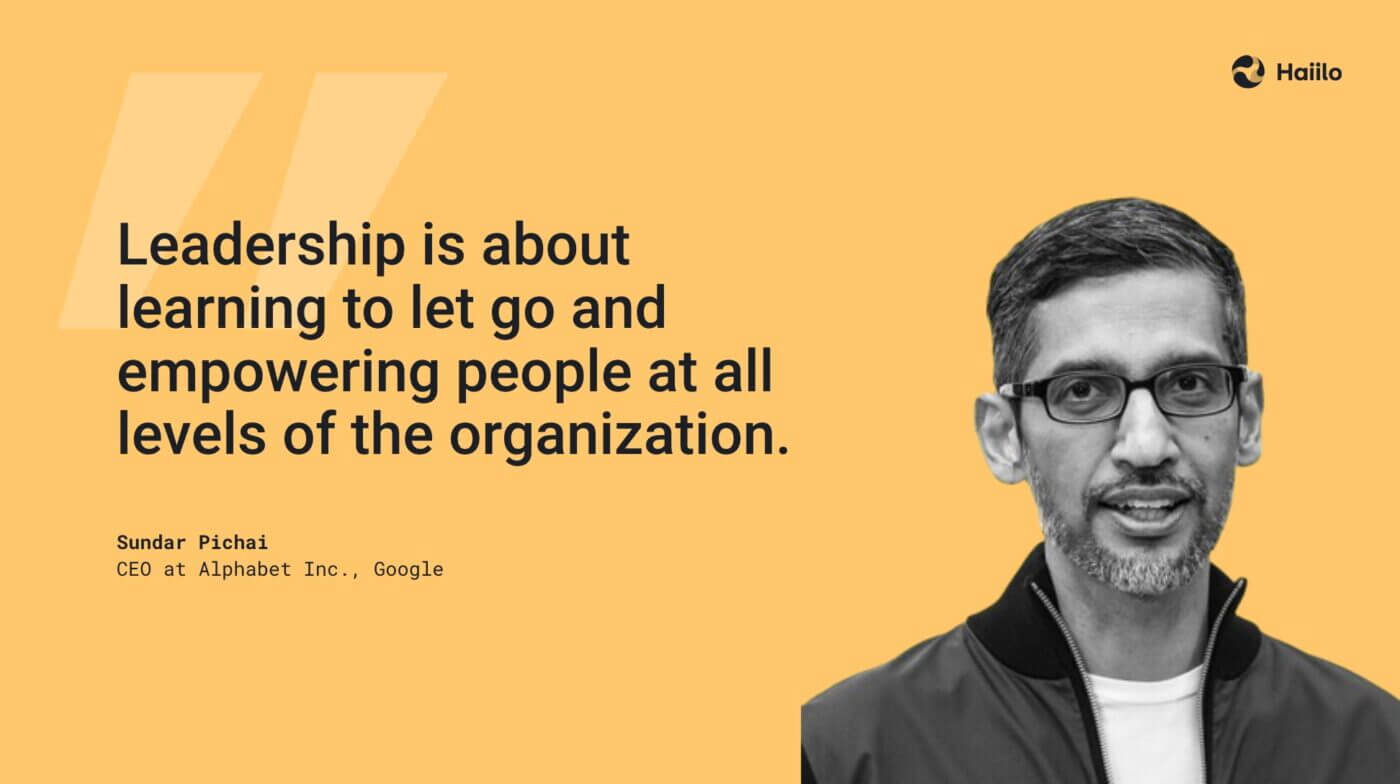What is the main difference between leadership and management? While many of you may think that these two terms mean the same thing, this is not the case. Moreover, leaders and managers can possess some very different skills and characteristics which we will cover later in this blog.
In this blog, you will also learn that proper communication is one of the main prerequisites for successful leadership and management.
💡Check out Top Leadership Skills and become the leader your employees need.
Now, let’s take a deep dive into the main differences between leadership and management.

How Leadership and Management are Different
Leadership and Management are often considered to have overlapping functions. While this can be true, these two terms have different meanings and shouldn’t be used interchangeably. Both imply a unique set of functions, characteristics, and skills that share similarities.
However, they show prominent differences in some circumstances. For example, some managers do not practice leadership, while others lead without a managerial role.
A manager is generally someone who is selected or appointed within an organization. In most cases, a manager is selected based on specific technical skills, knowledge, and expertise. On the contrary, the greatest leadership skill is to influence and inspire people.
For Great Leadership vs. Management you need the right communication tool to succeed in your role. Let us show you how.
In the workplace, it is important to have both great leaders and managers. Organizations need good leaders to achieve their mission and vision. They also need good managers to ensure that things are getting done and that their teams are aligned with the company’s goals.
Leadership vs. Management and their differences:
Let’s look at the 5 main differences between leadership and management.

Due to the impact of the recent pandemic, the role of leaders and managers in an organization has become even more important. Remote work and hybrid work can make it harder to influence people, impact employee experience, and ensure higher engagement levels.
💡 Read about the 20 ways to engage with your remote employees!
Now let’s look at leadership vs. managers specifically, and how they are different.
1. Leaders Set the Vision, Managers Follow It
When it comes to setting and executing a company’s mission and vision, managers and leaders have different roles.
Leaders are visioners. Most of them have a clear vision of where they want their organizations to be in the future. However, they themselves are not the only ones responsible for making that vision come true.
Here, managers play a crucial role. Leaders may be responsible, through efficient leadership communication, to transfer the company’s mission, vision and goals to the entire organization but managers are responsible for keeping employees aligned with the core company values and goals. However, 71% of employees believe that their leaders and managers do not spend enough time communicating goals and plans.
Even though managers are the ones who can influence people to work towards the same objectives, many employees agree that their company doesn’t do a good job communicating the company’s goals. Moreover, employees want and expect to be informed about how their organization is doing and where it is heading.
What do others say about Leaders vs. Managers
“I think of management as working with other people to make sure the goals an organization has articulated are executed,”
says HBS Dean Nitin Nohria in an interview for the online course Management Essentials.
“It’s the process of working with others to ensure the effective execution of a chosen set of goals. Leadership is about developing what the goals should be. It’s more about driving change.”

Moreover, by speaking openly about the company’s goals, opportunities, and challenges, leaders are the ones who can build trust in the workplace. They can foster a productive work environment where employees feel empowered to share their own ideas, needs and concerns. The more transparent leaders are, the healthier the work environment becomes.
💡 Learn more about the characteristics of a great leader.
2. Leaders Think Ideas vs. Managers Who Think Execution
Whilst a managerial culture emphasizes rationality and control, leaders are more about looking for opportunities for improvement on the organizational level. They do so by coming up with new ideas and driving the shift to a forward-thinking mindset. In other words, managers always look for answers to “how and when,” while leaders look for answers to “what and why.”
Therefore, the managers’ main responsibility is to fulfill their tasks based on the leader’s vision. Their main job is to ensure that people on different functions with different responsibilities operate efficiently, productively, and feel like they can share their voice.
They should always watch the bottom line by controlling employees and providing necessary information, processes, workflows and tools so that employees are enabled for success.
Managers relate to people according to the role they play in a decision-making process, whilst leaders, who are concerned with ideas, relate in more high-level but supportive ways. The main difference is simply between a manager’s attention to how things get done and a leader’s attention to what should be done to achieve greater results.
As leaders always look for new ideas, they can also play a crucial role in driving change within organizations. Moreover, a leader inspires positive, incremental change by empowering employees to work toward common objectives. A leader’s most powerful tool for doing so is efficient communication.
Change communication messages coming from leaders should get people prepared to do things differently and give the reason why, while managers should continuously reinforce these messages. Yet, many managers are not even aware of why a change is happening.
📹 Check out our Masterclass to learn about why every company should have a proper internal communications strategy.
3. Leaders Inspire People vs. Managers DrivingTheir Success
Whilst leaders have a great power to inspire people, managers are responsible for driving their continuous success and positive work experience throughout employee’s entire career journey.
As managers account for over 70% of employees’ engagement in the workplace, they are also held accountable for how successful and productive their teams are.
When people are not inspired by what leadership has to say, there is little managers can do to help their people succeed. By developing a personal leadership style through self-reflection, authentic communication and continuous feedback, leaders can empower their workforce, get their followers’ attention and inspire them to pursue important organizational initiatives.
Studies show that employees feel less stressed and under pressure when they have the opportunity to engage with the leaders regularly. Moreover, leadership has a great power to impact employee engagement.
Employees work more effectively within workplaces that support honest, open and transparent communication. Yet, many organizations still neglect the importance of two-way communication between leaders and employees. Instead, the information flows one way, and employees don’t have the opportunity to join company-wide conversations.

4. Leaders Look in the Future, Managers Work In the Present
One of the main differences between leadership vs. management is that leaders are more future-focused, while managers are more focused on the present.
Therefore, the manager’s most important goal is to achieve organizational goals by implementing processes and procedures around budgeting, organizational structuring, and staffing. On the other hand, leaders tend to think ahead and capitalize on future opportunities.
However, the leadership’s vision of the future means nothing if it can’t be transparently and clearly communicated to both managers and employees.

As one of the biggest drivers of employee engagement and experience in the workplace is the feeling of purpose and the alignment of employees’ personal and professional values, every leader should strive towards creating that sense of purpose among employees.
💡 Related: Lead more about the difference between various leadership styles such as servant leadership, transformational leadership, and empathetic leadership.
5. Leaders Shape the Culture vs Managers Endorsing It
When comparing leaders vs managers, it’s important to look at the organization’s corporate culture.
Culture is a system of values, beliefs, and behaviors that shape and determine how an organization operates and how the work gets done. When organizational culture is aligned to the overall business strategy, employees and other stakeholders act and behave in ways that support and enable the achievement of business goals.

When it comes to the organization’s culture, the difference between leadership and management is that leaders define and shape the culture. At the same time, the managers lead their employees to live up to that culture.
It is the leader’s duty to uphold the core company values and beliefs of the organization’s culture through their actions, authentic communication and their decisions. Passionate and inspiring leaders have a great power to communicate the organizational culture company-wide and influence employees’ behaviors.
Their skills and leadership styles have a big impact on how employees take and live that culture, while the manager’s role is to continuously support and endorse the culture within their teams.
Therefore, driving employees to live by the company’s culture and core values is impossible without the collaboration between leadership and management.
The Areas Where Management and Leadership Overlap
Even though the roles of leadership and management in the organization may vary, there are many areas where their duties and responsibilities overlap. The three main areas include:
- Communication: both leadership and management communication is crucial for an organization’s success. As mentioned earlier, employees expect to be informed and educated about where their company stands and heading. While leadership communication should inspire people, continuous and clear management communication empowers people to do their best and build stronger relationships among teams.
- Problem-solving and decision-making: effective decision-making and problem-solving is both the manager’s and the leader’s responsibility. While leaders may be responsible for decision making on a company-level, managers are held accountable for decision making on the team or departmental level.
- Change and crisis management: similar to decision making, leaders and managers should work collaboratively during times of change or crisis. The current world situation has taught us about the importance of agile workplace transformation and the need to quickly adapt to change. While leaders may have a better understanding of the change that needs to be implemented, managers have better knowledge around how to enable their employees to accept the change and align with it.
Top 10 Leadership and Management Skills
This video shows a great overview of the most important management and leadership skills.
According to the video, leadership is all about leading people towards a common goal, whilst management is all about the process of dealing with or controlling things and people.
The top 10 management skills include:
- Interpersonal skills
- Communication
- Motivation
- Organization
- Delegation
- Forward planning
- Strategic thinking
- Problem-solving
- Commercial awareness
- Mentoring
The top 10 leadership skills include:
- Communication
- Motivation
- Delegation
- Positivity
- Trustworthiness
- Creativity
- Feedback
- Responsibility
- Commitment
- Flexibility
7 Inspiring Quotes About Leadership vs. Management
Looking for inspiring quotes about leadership and management, here are some of the most popular ones:
- Effective leadership is putting first things first. Effective management is discipline, carrying it out. —Stephen Covey
- Lead and inspire people. Don’t try to manage and manipulate people. Inventories can be managed but people must be led. —Ross Perot
- Management is efficiency in climbing the ladder of success; leadership determines whether the ladder is leaning against the right wall. —Stephen Covey
- Management is about arranging and telling. Leadership is about nurturing and enhancing. —Tom Peters
- You manage things; you lead people. —Rear Admiral Grace Murray Hopper
- Management is doing things right; leadership is doing the right things. —Peter F. Drucker, author and educator
- The manager accepts the status quo; the leader challenges it. —Warren Bennis, American scholar, organizational consultant, and author
Empower Your Managers and Leaders with the Right Technology
With the rise of remote work, dispersed workforce and social distancing restrictions, both leaders and managers are faced with new challenges in the workplace.
Today, most organizations’ primary goal is to keep their dispersed employees connected, inspired and engaged even when they are physically separated. Additionally, they need to reach all their employees in a timely manner with relevant information, on any device, no matter where employees are located.
Luckily, modern employee apps and technology offer solutions for these challenges. A platform like Haiilo can enables managers and leaders to:
- Drive two-way workplace communications
- Create and share all the essential information in one place
- Bring their respective teams to one digital home
- Segment internal audiences in order to deliver information based on employees needs, preferences, job functions, locations and many more
- Enable mobile-first workplace communication
- Reach all employees in a timely manner, even those without a designated working space
- Enable employees to share their voice
- Encourage employees to become brand ambassadors
- Measure the impact of workplace communication on the overall business success










